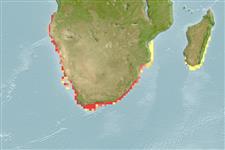>
Eupercaria/misc (Various families in series Eupercaria) >
Sparidae (Porgies)
Etymology: Rhabdosargus: Greek, rhabdos = stick + Latin, sargus = sargus (1591) (Ref. 45335).
More on author: Valenciennes.
Environment: milieu / climate zone / depth range / distribution range
Ökologie
seewasser; brackwasser benthopelagisch; ozeanodrom (Ref. 51243); tiefenbereich ? - 100 m (Ref. 3198). Tropical; 13°S - 36°S
Southeast Atlantic: Angola southward around coast of South Africa to Natal. Reported from Mozambique (Ref. 5213).
Length at first maturity / Size / Gewicht / Alter
Maturity: Lm 23.0, range 22 - 24 cm
Max length : 65.0 cm TL Männchen/unbestimmt; (Ref. 3688); common length : 40.0 cm TL Männchen/unbestimmt; (Ref. 3688)
Rückenflossenstacheln (insgesamt) : 11; Rückenflossenweichstrahlen (insgesamt) : 11 - 13; Afterflossenstacheln: 3; Afterflossenweichstrahlen: 10 - 11. Silvery with distinct crossbars (Ref. 3198).
Found over sandy substrate. Juveniles use estuaries as nurseries (Ref. 27121). Feeds on worms, crustaceans, and mollusks especially mussels (Ref. 5213). Spawns during spring and summer close inshore (Ref. 36731).
Conflicting descriptions of the reproductive style of this species have been reported, e.g., Ref. 4359 describe this species as being a gonochorist (Ref. 28504). Also Ref. 103751.
Bauchot, M.-L. and J.-C. Hureau, 1990. Sparidae. p. 790-812. In J.C. Quero, J.C. Hureau, C. Karrer, A. Post and L. Saldanha (eds.) Check-list of the fishes of the eastern tropical Atlantic (CLOFETA). JNICT, Lisbon; SEI, Paris; and UNESCO, Paris. Vol. 2. (Ref. 3688)
IUCN Rote Liste Status (Ref. 130435: Version 2024-1)
Bedrohung für Menschen
Harmless
Nutzung durch Menschen
Fischereien: weniger kommerziell; Sportfisch: ja
Tools
Zusatzinformationen
Download XML
Internet Quellen
Estimates based on models
Preferred temperature (Ref.
123201): 14.5 - 26.4, mean 23.8 °C (based on 102 cells).
Phylogenetic diversity index (Ref.
82804): PD
50 = 0.5156 [Uniqueness, from 0.5 = low to 2.0 = high].
Bayesian length-weight: a=0.01259 (0.00609 - 0.02604), b=3.03 (2.86 - 3.20), in cm total length, based on LWR estimates for this (Sub)family-body shape (Ref.
93245).
Trophic level (Ref.
69278): 3.0 ±0.2 se; based on diet studies.
Generation time: 6.9 ( na - na) years. Estimated as median ln(3)/K based on 1
growth studies.
Widerstandsfähigkeit (Ref.
120179): mittel, Verdopplung der Population dauert 1,4 - 4,4 Jahre. (K=0.16).
Fishing Vulnerability (Ref.
59153): Moderate to high vulnerability (54 of 100).
Climate Vulnerability (Ref.
125649): Moderate to high vulnerability (48 of 100).
Nutrients (Ref.
124155): Calcium = 72.5 [39.7, 137.6] mg/100g; Iron = 0.8 [0.4, 1.5] mg/100g; Protein = 18.4 [17.3, 19.5] %; Omega3 = 0.232 [0.139, 0.391] g/100g; Selenium = 65.5 [32.2, 121.5] μg/100g; VitaminA = 22.4 [7.0, 57.1] μg/100g; Zinc = 1.46 [1.01, 2.07] mg/100g (wet weight);
